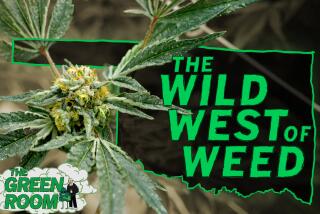Oklahoma field is lab for alternative fuel source
- Share via
GUYMON, OKLA. — Curtis Raines describes himself as “just a dumb old farmer” who’s not afraid to ask an obvious question: Why grow corn for fuel when it could be used to feed hungry people?
“That just doesn’t make a lot of sense to me,” Raines said.
The 64-year-old Oklahoma Panhandle farmer is growing a 1,000-acre plot of switchgrass, billed as the world’s largest of its type, to test whether the native plant can replace corn in making ethanol.
The Oklahoma Bioenergy Center project is designed to find out whether laboratory experiments using switchgrass to make ethanol can be duplicated on a large scale. The crop will help feed a biorefinery plant planned for southwest Kansas.
Switchgrass has advantages over corn.
As a perennial native to the Great Plains, it doesn’t need to be replanted and so takes less tractor fuel and fertilizer to produce. It can be grown on marginal land, doesn’t require as much water and, most important, isn’t used for food, so it wouldn’t drive up grocery prices.
“There are a lot of really nice characteristics that . . . pique one’s interest,” said Blake Simmons, a vice president at the U.S. Department of Energy’s Joint BioEnergy Institute in Emeryville, Calif.
It will be years before cellulosic biofuels -- such as switchgrass-based ethanol -- are produced at the same levels as corn-based ethanol, Simmons said. But the switchgrass research will answer important questions.
“We need to do some very massive projects very early on to find out the feasibility of this endeavor and see what improvements have to be made,” he said.
In recent years, production of ethanol has taken off with federal mandates aimed at easing dependence on foreign oil. Last year Congress decided to require a total of 36 billion gallons of biofuels to be blended into gasoline by 2022.
But food prices have increased along with ethanol producers’ heightened demand for corn.
Researchers have intensified their work looking into other ethanol ingredients, including cellulosic alternatives such as switchgrass, wood chips and even garbage.
Oklahoma’s energy secretary, David Fleischaker, said using switchgrass made sense, especially because rising food costs had “resulted in a pushback against renewable fuels.”
The switchgrass being used in the Oklahoma experiment was planted in June. A few months later it was just poking through the weeds. It will gradually take over the field, developing a deep root system and shading out the weeds.
Hitch Enterprises, one of the biggest agricultural operations in the Panhandle, is leasing the land for the study. Raines, a farm manager for the company, spent a week modifying his equipment to ensure the seed was planted in the way researchers recommended.
He maintains the fields while researchers make frequent trips from their offices in Ardmore to Guymon -- a 360-mile one-way trip -- to monitor progress.
The bioenergy center is a partnership of Oklahoma State University, the University of Oklahoma and the Samuel Roberts Noble Foundation.
In the first year after planting, about a quarter to a third of the switchgrass stand’s eventual yield can be harvested. That proportion jumps to about two-thirds after the second year and 100% after the third year.
The switchgrass will be taken to a $300-million biorefinery in Hugoton, Kan., 35 miles from Guymon, that soon will be built by Abengoa Bioenergy with the help of a $76.8-million grant from the Energy Department.
“The thing this plot has let us do is take the next step out of a research focus and put it in a real-world setting,” said Billy Cook, a consulting support research manager for the Noble Foundation.
For Raines, it’s all about common sense.
“I’m a farmer. I want good money for my crops,” he said. “But I don’t think taking corn and making gasoline is an answer to our problems.”
More to Read
Inside the business of entertainment
The Wide Shot brings you news, analysis and insights on everything from streaming wars to production — and what it all means for the future.
You may occasionally receive promotional content from the Los Angeles Times.








